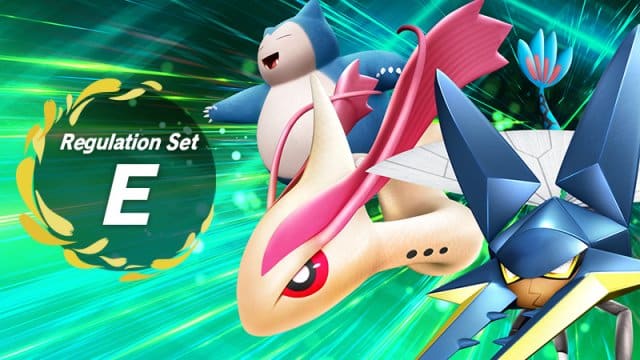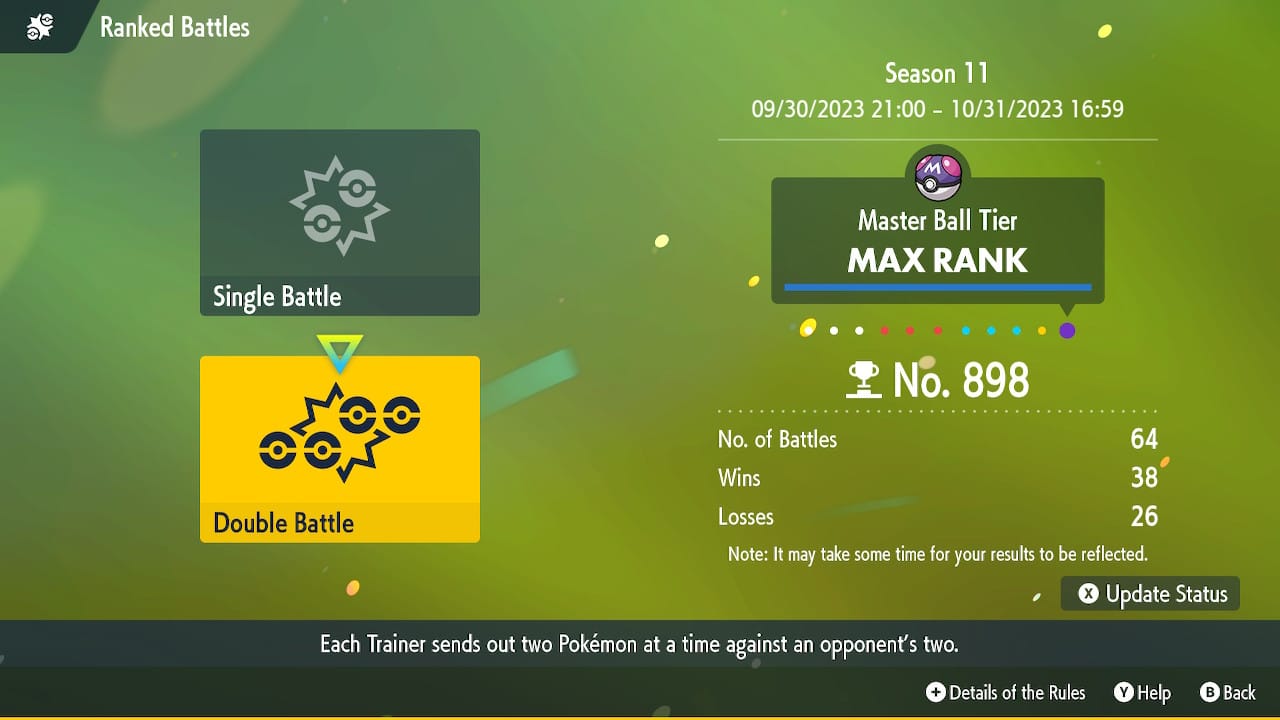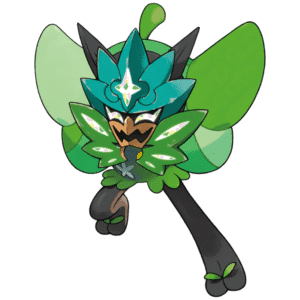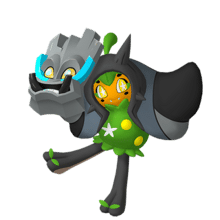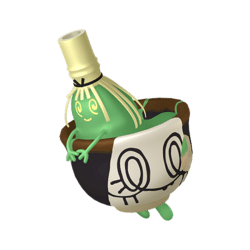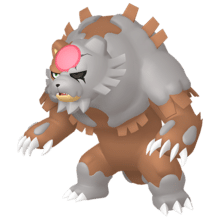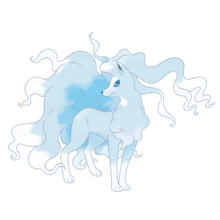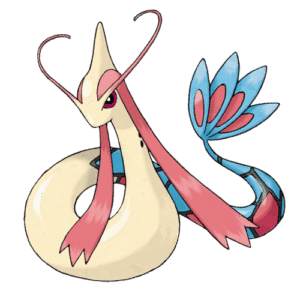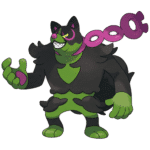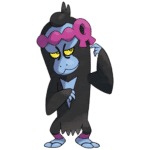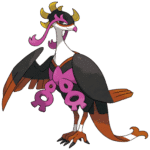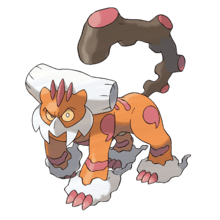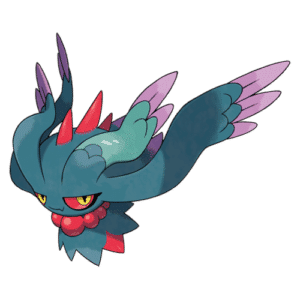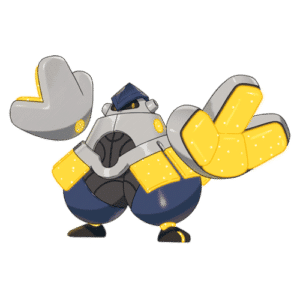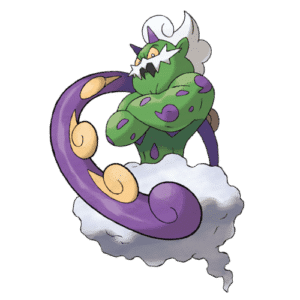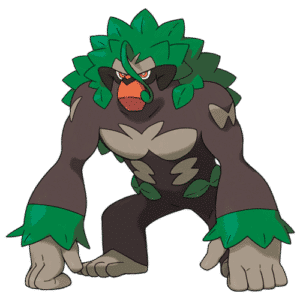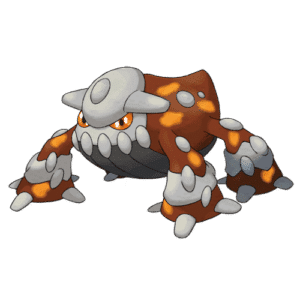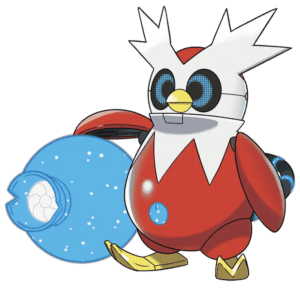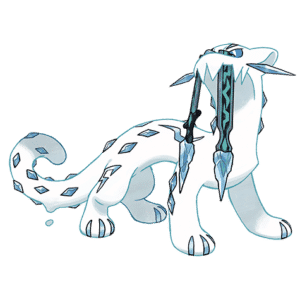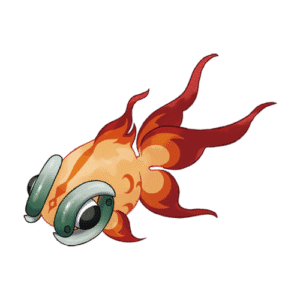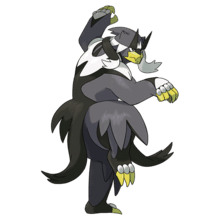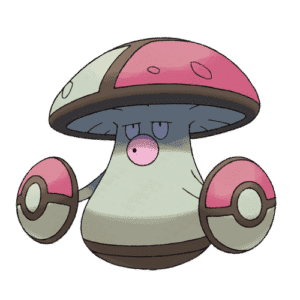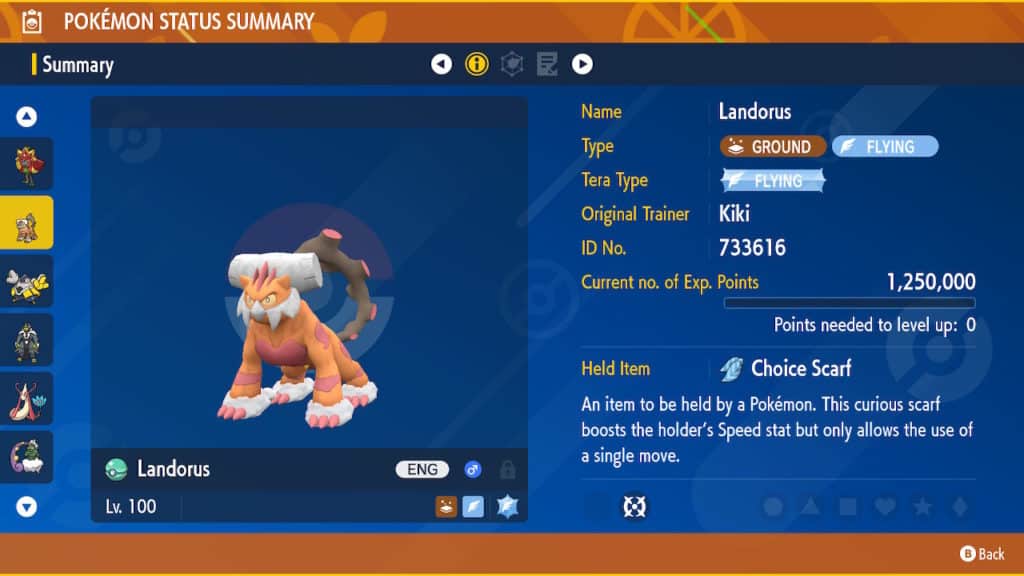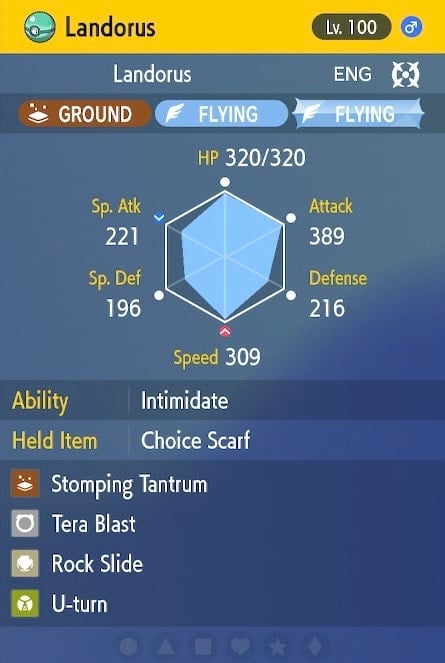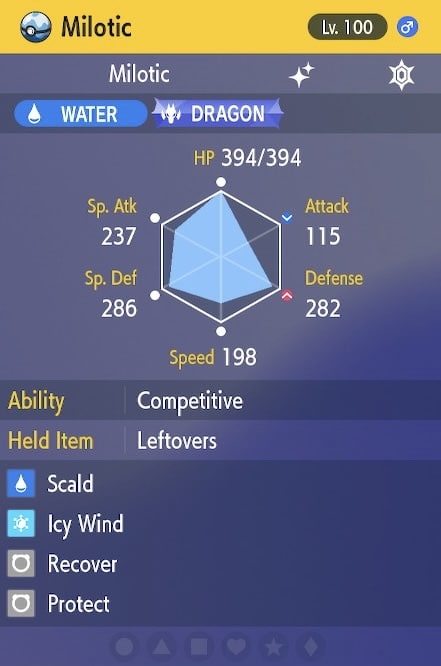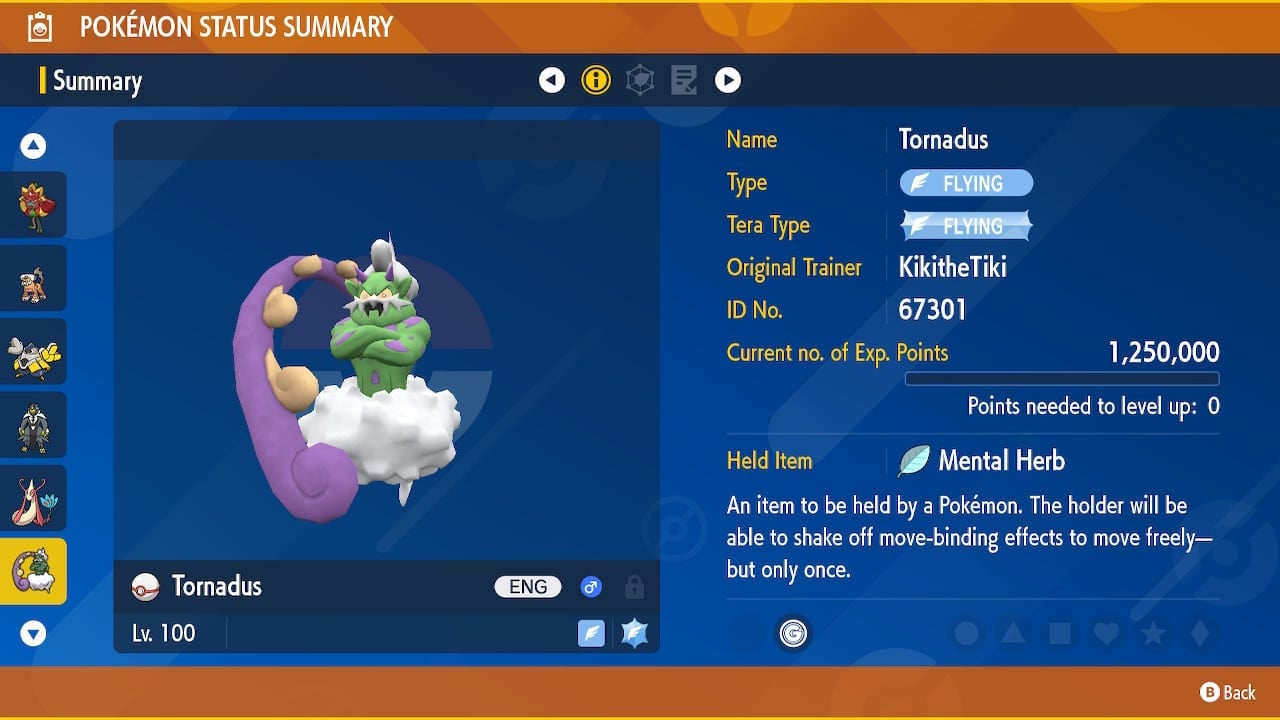One of the features in newer main series Pokémon games is an online ladder that allows Trainers to compete against each other using the same format as official Pokémon Video Game Championships (VGC) tournaments. Scarlet and Violet’s ruleset changes every few months in order to reflect updates to the game and to keep the competition interesting. The most recent ruleset, titled Regulation E, made its debut on October 1st. Regulation E introduced all of the new Pokémon that debuted in the Teal Mask DLC.
I recently laddered to top 1000 on the Scarlet and Violet ladder, a big personal goal I had for myself since I started playing VGC (I’m sorry I’m very proud of this and have an overwhelming urge to share it).
I thought it would be fun to go over what I’ve learned over the first two weeks of Regulation E and how I went about building my team, in case anyone was interested in exploring the world of VGC. It can be a bit daunting at first, but a bit of knowledge can make watching or playing VGC, either in game or on the online simulator Showdown, a much more engaging experience.
I am by no means a VGC expert. Much of what I learned came from online tools and content creators. I think its more fun to approach it from a semi-casual perspective, as I’m not constantly running calculations and accounting for every possible outcome on the fly, but I’ve still been able to compete at a decently high level for a casual player.
For a more detailed breakdown of how VGC works, refer to this article on the World Championships here. It touches upon some of the basic mechanics of VGC, as well as an overview of the rulesets.
Warning: this article may seem a bit overwhelming. My chaotic nerd brain sometimes can’t help but word dump a little bit. I would encourage you to use the Table of Contents to help you skip through the article as needed. However, if you’re really looking to get into VGC, I would recommend reading into my ramblings a bit more. Hopefully some of it will help. With that being said, let’s dive into it!
This article contains spoilers for the Scarlet Violet Teal Mask DLC
New Faces
The big buzz surrounding Regulation E is around the new Pokémon able to be used for the first time. Many are returning to the series for the first time in Generation 8, but there are a couple brand new faces that are shaking up the meta.
This section will be a little longer than the others due to these Pokémon making their debut. There will be a lot of information dumped here, but I promise the other sections won’t be as long. With that being said, let’s take a look!
Ogerpon
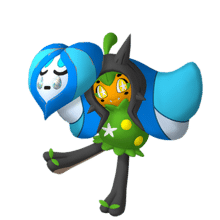

Type: Grass, Grass / Water (Wellspring Mask Form), Grass / Fire (Hearthflame Mask Form), Grass / Rock (Cornerstone Mask Form)
Abilities: Defiant, Water Absorb (Wellspring), Mold Breaker (Hearthflame), Sturdy (Cornerstone), Embody Aspect (Terastalized)
Common Items: Wellspring Mask, Hearthflame Mask, Cornerstone Mask, Leftovers, Life Orb
Common Moves: Ivy Cudgel, Horn Leech, Stomping Tantrum, Spiky Shield
Common Tera Types: Grass, Water, Fire, Rock
It seems quite fitting that the mascot of the Teal Mask DLC is leaving its mark on its debut format. Ogerpon is the newest addition to the roster of Legendary Pokémon, and it’s an interesting new player for sure. Its base form is a pure Grass type, but if it holds one of its signature Mask items, it adds a secondary typing corresponding to the Mask. Its base ability changes along with the mask, as well as the type of its signature move Ivy Cudgel. When Ogerpon Terastalizes, its Tera Type matches the type of its mask as well. Its ability changes to Embody Aspect, which boosts a stat again corresponding to its chosen Mask.
Of each of the forms, I would say that the Hearthflame Form is definitely the most common of the four. Its dual Grass / Fire typing is very unique, with the types covering many of the opposing type’s weaknesses. The stat boosted by Embody Aspect is its Attack stat, making it a threatening sweeper. Its base form’s ability, Mold Breaker, allows it to hit through Heatran’s Flash Fire ability, which would normally allow Heatran to wall Ogerpon.
While less common, Ogerpon’s Teal Mask and Wellspring Mask forms also see some play. Its Teal Mask form has the ability Defiant, which boosts its Attack stat by two stages whenever it has a stat lowered, allowing it to counter any opponents with Intimidate. It also frees up its Item slot since it doesn’t need to hold a Mask, allowing for some more diverse builds. Alternatively, the Wellspring Mask can help it play more of a defensive role. Its Embody Aspect boosts its Special Defense, which can pair well with some of Ogerpon’s more defensive options for moves. It has good enough base Attack that it can safely invest in its bulk while still outputting decent damage. Its Cornerstone Mask form is noticeably less used than its other forms.
Ivy Cudgel is a 100% accurate, 100 base power move that doesn’t make contact and has a high critical hit chance, making it a staple on all Ogerpon builds. It gets access to Spiky Shield, a better version of Protect that damages opponents that make contact with it. There are pretty much no scenarios where you wouldn’t run Spiky Shield over Protect. Stomping Tantrum provides good coverage while Horn Leech provides recovery while dealing damage.
Ogerpon is also the only Grass type to learn Follow Me. Redirection is a key aspect of VGC, as you can protect your partner Pokémon from opposing attacks. Rage Powder is a much more common variation, especially used on Pokémon like Amoonguss. Amoonguss was a threat because of its 100% accurate Sleep-inducing move Spore. Spore doesn’t affect Grass types, so naturally you’d redirect it with a move like Rage Powder, right? Unfortunately, Grass types can ignore Rage Powder, free to Spore their opponents around Rage Powder. Follow Me cannot be ignored by Pokémon of any type, but up until now, there were no Grass types that could learn it, so there was no way to redirect Spore into a Pokémon that was immune to it. Ogerpon changes that, being the first ever Pokémon to be able to redirect Spore.
Sorry for the long winded nerdy info dump. Long story short, Ogerpon is very good, able to do pretty much anything, and teams will be required to have some sort of answer for it.
Sinistcha
Type: Grass / Ghost
Abilities: Hospitality, Heatproof
Common Items: Focus Sash, Leftovers, Life Orb
Common Moves: Matcha Gotcha, Shadow Ball, Rage Powder, Trick Room
Common Tera Types: Water, Fire
The new Convergent Pokémon Sinistcha is a relative of Polteageist, a Ghost type from Galar that hasn’t been released in Pokémon GO yet. This new form is inspired by the traditional method for preparing Matcha with a straw whisk. Sinistcha’s pre-evolution, Poltchageist, was teased prior to the DLC’s release, but I don’t think anyone could have predicted the amount of play this little guy would see.
I think Sinistcha’s ability is a good place to start. While Heatproof is definitely useful, Hospitality is the go to Ability for most builds. Upon switching in, Hospitality will heal Sinistcha’s teammate by 25%. This is extremely useful in VGC, as that small amount of healing can make the difference between your partner surviving an attack that would have KO’d it otherwise. This is especially useful on Pokémon that require some setup to get going. Additionally, this ability can be used multiple times throughout the battle, so switching out Sinistcha allows for some healing later in the game.
Sinistcha’s signature move, Matcha Gotcha, is surprisingly strong for a move with such a silly name. Matcha Gotcha is an 80 base power Grass move that hits both opponents and heals Sinistcha based on the amount of damage dealt. It also has a chance to burn opponents. Its only drawback is being 90% accurate, but given how strong this move is, I would say the accuracy nerf is more than balanced.
Due to it’s nature as a support Pokémon, Sinistcha usually takes on a more defensive build. It has decent bulk stats that can be bolstered through EV’s, and its base Special Attack is high enough that it can dish out decent damage without any investment. It gets Rage Powder to again support its set up allies, as well as Trick Room to help turn the tables in certain situations. However, it can also be utilized as an offensive Pokémon. Investing into its already great Special Attack can help this little guy hit pretty hard. I got messed up pretty bad by a Life Orb variant, which was paired with Trick Room to help tear through my team. Matcha Gotcha pairs well with both types of builds, allowing you to heal and potentially burn your opponents as you stall them out, or hitting hard enough to heal enough HP back after taking a few hits.
I’m excited to try and implement this Pokémon onto a Trick Room team some time soon!
Bloodmoon Ursaluna
Type: Ground / Normal
Abilities: Mind’s Eye
Common Items: Throat Spray, Life Orb, Leftovers
Common Moves: Blood Moon, Earth Power, Hyper Voice, Calm Mind
Common Tera Types: Normal, Ghost
This was a surprising addition in the DLC to be sure. An Ursaluna that swam from Hisui to Kitakami in ancient times, this Ursaluna has undergone a transformation empowered by the Blood Moon. It is able to be encountered through a side quest in the DLC. But how does it compare to its more familiar counterpart?
For starters, Bloodmoon Ursaluna is slow, just like its regular form, meaning that you will similarly find it most useful under Trick Room. However, the two forms differ in usage due to Bloodmoon Ursaluna being a Special Attacker, whereas its normal form is a Physical Attacker. Its ability, Mind’s Eye, is a combination of the best aspects of 3 existing abilities, being Scrappy, Keen Eye, and No Guard. It can hit Ghost types with Normal and Fighting moves, can’t have its Accuracy lowered, and its moves ignore the target’s Evasion. While normal Ursaluna relies on its ability Guts to output its insane damage, that means it is usually limited to using the Flame Orb ability to guarantee the Burn status is applied. Bloodmoon Ursaluna has a bit more flexibility in its item choices. From my experience, Throat Spray was its item of choice, which makes sense given its common move choices.
Bloodmoon Ursaluna’s signature move, Blood Moon, is an extremely powerful Normal type move. It is 140 base power with 100% accuracy, with the only caveat being it cannot be used twice in a row. However, unlike Hyper Beam, Ursaluna is free to use any other move or switch out, rather than being forced to recharge. However, while most Bloodmoon Ursaluna still run its signature move, that is not the most common Normal move I’ve faced.
Hyper Voice is a 90 base power, 100% accurate Normal move that hits both opponents. It is classified as a sound move, meaning that it activates the Throat Spray upon being used. Throat Spray boosts the user’s Special Attack by one stage, meaning Ursaluna can power itself up simply by attacking. It’s ability allows it to hit Ghost types, meaning Hyper Voice is only resisted by [stee] and Rock types, which it can then hit with STAB Earth Power. There is some potential for setup with Calm Mind and Leftovers, but +1 Tera Normal Hyper Voice takes much less to set up and is equally if not more threatening.
Bloodmoon Ursaluna has been making waves in Regulation E. We’ll see how it stacks up against its normal form over time!
Ninetales
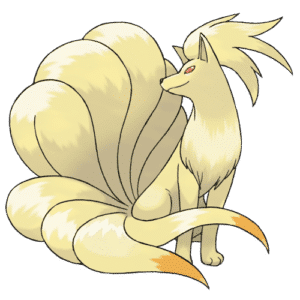
Type: Fire (Kanto), Ice / Fairy (Alola)
Abilities: Flash Fire, Drought (Kanto), Snow Cloak, Snow Warning (Alola)
Common Items: Heavy Duty Boots, Eject Pack (Kanto), Light Clay (Alola)
Common Moves: Heat Wave, Overheat, Will-O-Wisp, Helping Hand (Kanto), Blizzard, Aurora Veil, Moonblast, Icy Wind (Alola)
Common Tera Types: Grass (Kanto), Water (Alola)
While a lot of the returning Pokémon in the DLC have some nice play, both Ninetales forms have made an immediate impact on the format due to their role as weather setters. In the base game of Scarlet and Violet, weather setters were extremely limited, with there only being one evolutionary line to feature the abilities that set Sun, Rain, and Snow (although Rain is irrelevant for this conversation). Torkoal and Abomasnow were the only Pokémon with the abilities Drought and Snow Warning respectively, and while both of them aren’t bad Pokémon by any means, Torkoal is pretty limited to Trick Room and Abomasnow has horrible secondary typing and also isn’t that fast. Both Ninetales forms are able to set up the weather upon switching in and are fast enough to move before most opponents. Alolan Ninetales sees much more play, so we’ll touch on Kanto Ninetales briefly first.
Ninetales has benefits over Torkoal in that it can move before many of its opponents, whereas Torkoal is extremely slow and will often take a hit before moving. It can hit both opponents with sun boosted Heat Wave, burn opponents with Will-O-Wisp, or use an Eject Pack to switch out after the stat drop from using Overheat in order to switch in and set the sun back up later. Common partners for Ninetales are Hisuian Typhlosion, Flutter Mane, and Roaring Moon, as the Sun boosts Typhlosion’s Eruption and activates the Paradox Pokémon’s Protosynthesis abilities. Helping Hand can help boost its partner’s damage output further, but this is something that Torkoal with a defensive build can also do. While not dominant by any means, Kantonian Ninetales is definitely one of the more prominent returning Pokémon.
Alolan Ninetales was indirectly buffed, since Scarlet and Violet replaced the Hail weather with Snow. While it doesn’t deal passive damage to non-Ice types like Hail did, it passively boosts Ninetales’s defense, helping it do its job more effectively. The biggest thing that Ninetales has going for it is access to Aurora Veil. This move is Reflect and Light Screen in one move, but the caveat is that it must be Snowing in order for the move to be used. Ninetales is fast enough that it can get out before many opponents and set up Aurora Veil before it takes damage, thus reducing any incoming damage. This lasts for 5 turns, or 8 turns if Ninetales is holding the Light Clay item. Once this is set up, Ninetales can fire off Blizzards that can never miss, lower the opponent’s speed with Icy Wind, and more. It pairs particularly well with Iron Bundle, another frail Ice type that benefits from the defensive buff.
Both Ninetales are utility Pokémon that have the potential to do some decent damage if left alone. For many players, these two have become the go-to weather setters in Regulation E.
Milotic
Type: Water
Abilities: Marvel Scale, Competitive, Cute Charm
Common Items: Leftovers
Common Moves: Scald, Icy Wind, Ice Beam, Recover, Hypnosis, Coil
Common Tera Types: Dragon, Grass
Milotic is a fan favorite that has thankfully been made much more accessible since its debut in Hoenn. Milotic may not seem extremely powerful on paper, but it plays very differently than most of the Pokémon in the format. Milotic is meant to be a bulky stall Pokémon. Most Trainers invest fully in this bulk, which, when paired with Leftovers and Recover, can make Milotic extremely difficult to remove from the field.
Milotic is one of the only Pokémon in Generation 9 to get access to Scald, an 80 base power Water move that has a chance to burn the target. Many Water Pokémon lost their viability due to losing this move that was a staple for so many years. Scald will never be doing insane amounts of damage, but it is consistent and the burn chance means you cannot ignore Milotic. Icy Wind allows for some speed control, which again means it can’t be ignored. There is some interesting stuff you can do with Coil and Hypnosis, boosting accuracy and spamming sleep, but this isn’t as common.
Milotic is surging in viability not because it alone is great, but because of its matchup against one of the more prominent threats: Landorus-Therian. We’ll touch upon this more in the “Returning Favorites” section, but TLDR, Lando matches up incredibly well into Ogerpon thanks to its typing, movepool, and ability Intimidate. However, Intimidate is the reason Milotic matches up so well into Landorus. Its ability, Competitive, boosts its Special Attack stat by two stages whenever any stat is lowered, so if Landorus and Milotic both start the battle on the field, Milotic will have a free +2 in Special Attack. Pair that with a physically defensive build to help survive Lando’s attacks, as well as Ice coverage in either Ice Beam or Icy Wind, and Milotic’s strength is suddenly very apparent. A bit of a spoiler, but Milotic was the piece that helped my team come together and start finding success!
The Loyal Three
This is more of an honorable mention than a true entry. All three of this new sub-Legendary trio have access to the signature ability Toxic Chain, which has a chance to poison the opponent with any attacking move. Unfortunately, this doesn’t do much to boost their viability, as it is largely up to chance. They all have hidden abilities as well, but only Okidogi’s is really useful. I would say the most useful is Fezandipiti, but none of them have shaken up the format like the previously mentioned Pokémon have.
Phew. Sorry, that was a lot. I promise the other sections won’t be as long. Let’s move on to the next section!
Old Favorites
While Regulation E introduced a lot of new Pokémon, every other Pokémon that was legal in its predecessor, Regulation D, is still able to be used. While some Pokémon have certainly fallen off in usage, many of the staples of the format still remain. Here are some faces that I saw regularly throughout my Regulation E journey!
Landorus (Therian)
As mentioned previously, Landorus-T matches up extremely well against Ogerpon, which is on the majority of teams due to its novelty and strength. Most are running Tera [Flying] and Tera Blast, which can deal massive damage to most neutral targets. Lando was already powerful, just as it has been in every format it has been legal in, but Ogerpon’s introduction has caused a spike in its usage in Regulation E.
Flutter Mane
Flutter Mane maintains its spot as the most used Pokémon in the format once again. While not as dominant as in Regulation D, it is just as powerful. Tera Fire is more common due to Ogerpon’s prevalence, but Tera Fairy is still extremely deadly as well. Again, it is basically guaranteed that you will fight this thing at some point.
Iron Hands
Iron Hands again is just as viable as it was previously. It has now claimed the 2nd place spot in usage, due to a certain Pokémon falling from grace a bit (scroll ahead if you want to know what that Pokémon is). It still rarely utilizes its Ability Quark Drive, yet it still terrorizes the meta. Tera Grass is still an excellent choice, but other Tera types have risen in relevance thanks to some new threats rising and old threats fading out. Have fun getting this thing off the field…
Tornadus
Tornadus returns as the premiere Tailwind setting of the format. Combining this with its signature move Bleakwind Storm, alongside other great supporting options such as Taunt, Rain Dance, Sunny Day, and more, and Tornadus can help fill any niche support role your team may need.
Rillaboom
Rillaboom has somewhat returned to its former glory thanks to some new moves brought back in the DLC. Grassy Glide and High Horsepower both returned in the DLC, giving Rillaboom back the tools it used to dominate in Sword and Shield’s competitive scene. Grassy Glide has been nerfed, but Rillaboom can still make great use of it paired with its Hidden Ability Grassy Surge. Rillaboom is definitely up there for Pokémon that benefitted the most from the DLC.
Heatran
Heatran largely plays the same role it played in Regulation D. It has a pretty good matchup into Ogerpon, but most Ogerpon are running Ground coverage specifically for Heatran and Hisuian Arcanine. Tera Grass may seem like the obvious answer, but Hearthflame Mask Ogerpon has Mold Breaker, allowing it to hit Heatran with fire moves through Flash Fire. However, once it Terastalizes, it loses Mold Breaker, so Tera Grass Heatran can wall Ogerpon in the right situations.
Iron Bundle
Iron Bundle was never bad, per se, but it has definitely seen a spike in usage thanks to the introduction of Alolan Ninetales. Having the benefits of Snow plus Aurora Veil makes this speedy little robot aa more prominent threat. It sill unfortunately has to rely on Hydro Pump as its only viable Water STAB option, though.
Chien-Pao
Chien-Pao again plays very similarly to Regulation D. Tera Ghost, Focus Sash item, Ice Spinner/Avalanche, Sucker Punch, Sacred Sword, Protect. It’s ability also benefits Ogerpon by helping it take KO’s thanks to lowered defenses. Not much else to say here.
Chi-Yu
Similarly to Chien-Pao, Chi-Yu is mostly the same. Definitely a threat when paired with Flutter Mane. It also matches up positively against Ogerpon, so there’s that as well. Again, not much to say.
Fallen From Grace
This is where things get interesting. There aren’t many entries here, but the two that are here are definitely deserving. It’s not to say that these Pokémon aren’t usable anymore, but their viability has definitely dropped from Regulation D to Regulation E.
Urshifu (Rapid Strikes)
Urshifu was one of the most potent threats in Regulation D. Its signature move, Surging Strikes, hits 3 times and is guaranteed to crit each time. Its Ability, Unseen Fist, allows it to bypass Protect and other similar moves. This thing was a beast.
Urshifu-R has dropped from 42% usage in Regulation D to 12% in Regulation E. Being able to deal neutral damage to Ogerpon at best (before Terastalizing) isn’t great, and it can be hit by STAB Grass moves in return.
Urshifu is far from bad. It still does extremely powerful neutral damage to most targets. It simply isn’t dominating the format like it used to, definitely qualifying it as a fall from grace.
Amoonguss
Amoonguss is the biggest loser, dropping from 35% usage in Regulation D to 11% in Regulation E. I already mentioned a bit about why Amoonguss got worse in Ogerpon’s section, but long story short, Ogerpon basically invalidates Amoonguss, especially the Hearthflame Form. It also matches up poorly against Landorus-T, Tornadus, Rillaboom, Sinistcha, and many more. Again, it is far from useless, but the meta has shifted, and Amoonguss definitely got the short end of the stick.
Conclusion (kinda)
And there we have it! these are some of the things I picked up throughout the past two weeks playing Regulation E. That should be enough information to get you started in VGC, whether its playing casually or watching. However, if you want a bit of insight into team building, stick around for the next section!
The Team
And now we’ve reached the team building section of the article. These 6 Pokémon are the ones I used to hit top 1000 on the in game ladder. I am by no means a team building expert, but this team works surprisingly well together. Their movesets and items are listed below.
As you can see, power creep is definitely real in Regulation E. 4 of the Pokémon are Legendary, one is a Paradox Pokémon, and the Milotic is shiny just to flex a bit. I’ll go over how I picked certain team members.
Ogerpon (Hearthflame Mask)
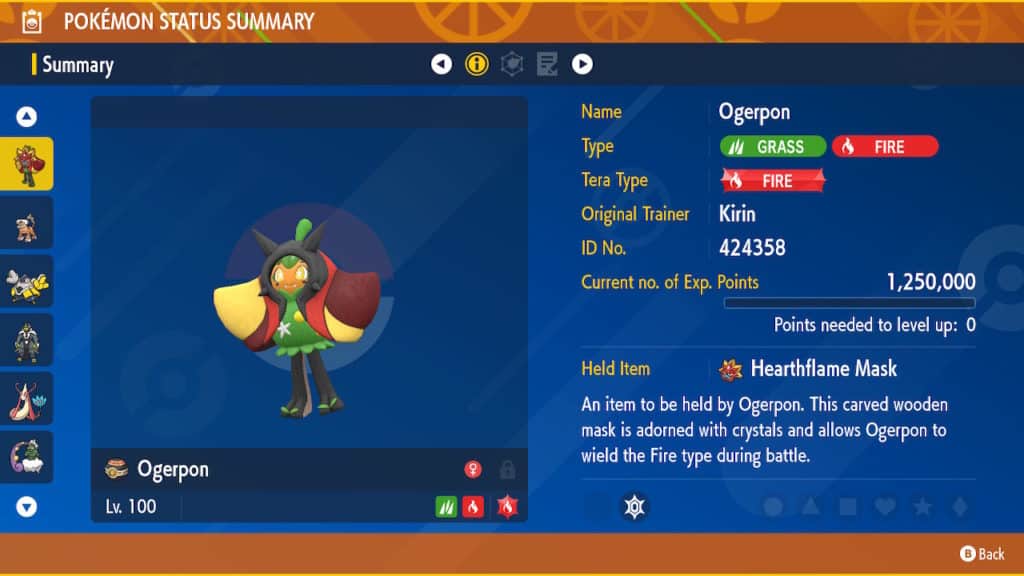
I knew I wanted to center the team around Ogerpon, just like the majority of Trainers right now. I originally started with the Teal Mask form, as I liked having Defiant to help deter opposing Pokémon with Intimidate. The vast majority of Ogerpon are hyper offensive, with max Attack and Speed, so I wanted to do something a bit different. Ogerpon has strong base Attack, so I gave it an Attack boosting Nature and invested the rest of the EV’s into its bulk. Additionally, I gave it Leech Seed, an uncommon move choice for sure. It helps me chip down bulkier Pokémon and pairs well with Spiky Shield and the Leftovers item. However, I found the team to be lacking in Fire coverage. I switched out the Leftovers for the Hearthflame Mask. This allows me to still take KO’s with Ogerpon if it Terastalizes, as it gets an Attack boost. Horn Leech replaced Stomping Tantrum, in order to have Grass coverage as well as to replace the passive healing from Leftovers. My Ogerpon tends to win the matchup against other Ogerpon thanks to the bulk investment and high crit rate of Fire type Ivy Cudgel.
Landorus (Therian)
Landorus (Therian) was my next addition to the team, largely because of the prevalence of opposing Ogerpon. Tera Tera Blast is extremely powerful and allows me to threaten opposing Ogerpon and Rillaboom, and it does good neutral damage to a lot of targets. Intimidate is the primary reason Landorus-T is a threat, as it drops both opponent’s Attack stat by one stage every time it switches in. This pairs well with U-Turn, which allows Landorus to switch out and switch back in as needed. Paired with the Choice Scarf item, Landorus can easily pivot out of bad matchups or outspeed and KO targets with STAB Stomping Tantrum or Rock Slide for coverage. If the opponent’s team isn’t focused on Special Attackers and doesn’t have any Pokémon with the Defiant or Competitive abilities, then Landorus is usually coming to the battle.
Iron Hands
Iron Hands was next. It’s extremely powerful and difficult to remove from the field. It can usually withstand being doubled into by the opponent, and has even survived some direct STAB attacks like Earthquake or Dazzling Gleam. It is naturally slow, so running a max speed Iron Hands allows it to outspeed opposing Iron Hands’s Fake Outs, but also helps it underspeed some opposing Pokémon under Trick Room naturally, even with max Speed IV’s. The Assault Vest item adds to its bulk, buffing its Special Defense at the cost of only being able to use attacking moves. Drain Punch is reliable Fighting STAB that also offers recovery, and Wild Charge can take easy KO’s on even neutral targets, with Iron Hands not even taking too much recoil due to its absurd HP stat. Fake Out helps me position well at the beginning of the battle, or can help slow an opponent’s momentum mid or late battle.
While in the past Iron Hands typically ran Tera Grass to resist Ground and Water moves (specifically Urshifu’s Surging Strikes) and become immune to Spore, many of these threats have become less prevalent in Regulation E. I found that Tera Fire is extremely useful, allowing it to tank Fairy hits from Flutter Mane and hit back with a one-shot Heavy Slam. It also makes Iron Hands immune to being burned, which could potentially stop it in its tracks. This also helps it take incoming Fire and Ice damage from Sun and Snow teams that have become much more common. Tera Fire Iron Hands was the unexpected MVP of the team, coming to most if not all battles.
Urshifu (Rapid Strikes)
Urshifu may have dropped off in usage, but it is still incredibly powerful. Its signature move, Surging Strikes, always hits three times, and each is guaranteed to crit. Paired with its Unseen Fist ability, which can ignore Protect, and you have an offensive menace. I originally had it equipped with the Life Orb item, which boosts its Attack even further at the cost of some HP per turn. However, I found that the extra damage often didn’t make the difference, and that I could bolster its offenses in other ways. I found that Urshifu being guaranteed to survive an attack with the Focus Sash was much more helpful. Tera Water Surging Strikes can sometimes win you the game right off the bat, especially with the right partner. Paired with a Prankster Rain Dance from Tornadus, this can do some serious damage, even without the Life Orb. Close Combat is great for cleaning up anything that resists Water, and Aqua Jet’s priority combined with the ability to ignore Protect helps to clean up weakened foes. Urshifu may not be dominating the format anymore, but it is still a threat to be sure.
Milotic
Yes it’s shiny, and yes, I got it legitimately. Kinda. Had to date skip for the Feebas outbreak, but it’s not hacked or transferred in or anything.
Milotic was the missing piece to the puzzle that helped my team begin to actually function at a competitive level. I previously had Chien-Pao on the team to help my army of Physical Attackers tear through opponents. However, therein was my issue. My team was comprised entirely of Physical Attackers, and I had no counter for Intimidate other than Ogerpon (Teal Mask form at the time). Landorus and Hisuian Arcanine are the most prominent Intimidate users, and Chien-Pao just wasn’t cutting it.
I was playing decently with the Chien-Pao variant of the team, having reached Master Ball tier, but my win-loss ratio was atrocious. I then played against a team with a Milotic that absolutely tore through my team. I couldn’t get rid of it, especially once it Terastalized to Dragon to resist its only weaknesses in Grass and Electric. I knew right there it was the answer to my struggles.
Milotic is extremely bulky, and it has near unlimited recovery between Recover and the Leftovers item. Fully investing in its HP and Defense stats to help take hits from threats like Iron Hands and Ogerpon, Milotic’s offensive options’ secondary effects still made it a threat. Scald is 100% accurate and has a chance to burn, leaving Physical Attackers crippled, and Icy Wind helps to control the opponent’s speed.
However, its Milotic’s ability that is key. Competitive raises Milotic’s Special Attack by 2 stages whenever a stat is lowered. So say that my opponent starts the battle with Landorus, hoping to slow down Ogerpon, Landorus, Iron Hands, or Urshifu with Intimidate. Instead, it is met with Milotic, which gets to start the battle with its Special Attack stat doubled. Milotic can hit Landorus back with Scald to try and get the burn or Icy Wind, which easily does over half of Lando’s HP. Even if we get the lead prediction wrong and Landorus doesn’t come out, Scald and Icy Wind are great at controlling the opponents, and it is very unlikely that Milotic gets taken out of battle in one hit. I owe a lot of my success to this graceful sea serpent.
Tornadus
Rounding out the team is Tornadus, Landorus’s pure type sibling. Fun fact, but this Tornadus was actually caught in Pokémon GO! I transferred it to Pokémon HOME during a storage cleanout and thought it would be fun to use in Scarlet and Violet!
Tornadus is much more viable in its Incarnate form rather than its Therian form due to having access to the ability Prankster. This allows Tornadus to use non-damaging Status moves with increased priority. This means I can use Tailwind before my opponents get a chance to attack, and Tornadus’s partner can usually move before its opponents. Additionally it is able to use Rain Dance before Urshifu moves to help bolster its offenses. Prankster Rain Dance also has the benefit of being able to stop opposing Sun teams in their tracks. Opponents lead with either Torkoal or Kantonian Ninetales to set up sun, either next to a powerful Fire type attacker or a Paradox Pokémon with Protosynthesis to boost one of its stats. Rain Dance moves first thanks to Prankster, shutting of Protosynthesis and changing incoming Fire moves from being 1.5 times as strong to 0.5 times as strong instead. Its signature move, Bleakwind Storm, hits both opponents and has a chance to lower their speed, which is balanced by the fact that it only has 80% accuracy. However, Rain Dance also solves this, as Bleakwind Storm bypasses the Accuracy check to always hit when it is raining.
Tornadus’s role is to stay on the field to support its team. It is holding a Mental Herb item to help it remove the effects of any Taunt users on the opposing team, which would otherwise force Tornadus to only use attacking moves for a few turns. While Tornadus itself can learn Taunt and can use it with priority thanks to Prankster, I found Protect to be more useful. It can be the difference in Tornadus survivng one more turn in order to set up another Tailwind. Tornadus’s Tera type is supposed to be Ghost. This allows it to become immune to opposing Fake Outs, in order to guarantee Tailwind goes up on the first turn. Looking at the screenshot above, I’m realizing that I never changed its Tera type. Oops. However, I think this shows you how often I actually used that option. In my entire journey to top 1000, I didn’t use Tera Ghost once. If I see a Fake Out coming, I usually just Protect, then Tailwind the next turn. Maybe I should look at other options for Tera types. Tera Grass or Ground could be interesting to help stop incoming Super-Effective attacks. I guess I’ve still got some work to do on the team.
Team Usage
And there’s the team! I’m genuinely surprised that I managed to put together a functioning team, but these six Pokémon have managed to overcome most obstacles thrown their way. I usually like to lead with some combination of Landorus, Tornadus, and Iron Hands. I usually like the two genies up front, as I can U-Turn and Protect first turn to help get better position. However, if I see an Intimidate user on the opposing team, Milotic will usually take the lead instead, partnered with one of the mentioned three depending on the matchup. If I see bulky Pokémon such as Eviolite Dusclops or Iron Hands on the other team, I’ll usually bring Ogerpon to help chip them down over time. My go-to team against Trick Room teams is usually Iron Hands, Tornadus, Urshifu, and either Ogerpon or Milotic depending on the matchup. I usually end up Terastalizing Iron Hands, although Ogerpon and Landorus have come in clutch with a few matchups. Urshifu is rarer, as I can usually boost its attack enough with Tornadus’s Rain Dance, but it again has saved me in a few matchups. Milotic is rare to Tera, but Tera Dragon can help me stall out opponents in certain situations. As mentioned previously, Tornadus literally never Terastalized.
Using this team definitely had a learning curve, but I eventually fell into a rhythm and I’m proud to say I’ve gotten the hang of it!
Conclusion (for real this time)
If you made it this far, thank you! A lot of this article may seem like the ramblings of a madman to a lot of you, but hopefully you were able to take something away from it. If you ever want to talk VGC, hit me up on Discord! I’m by no means an expert, but I’m always looking to learn more! That’s all for now though. Hopefully I’ll see some of you out there on the battlefield!

